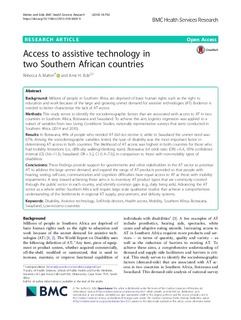| dc.description.abstract | Background Millions of people in Southern Africa are deprived of basic human rights such as the right to education and work because of the large and growing unmet demand for assistive technologies (AT). Evidence is needed to better characterize the lack of AT access. Methods This study serves to identify the sociodemographic factors that are associated with access to AT in two countries in Southern Africa, Botswana and Swaziland. To achieve this aim, logistics regression was applied to a subset of variables from two Living Conditions Studies, nationally representative surveys that were conducted in Southern Africa (2014 and 2010). Results In Botswana, 44% of people who needed AT did not receive it, while in Swaziland the unmet need was 67%. Among the sociodemographic variables tested, the type of disability was the most important factor in determining AT access in both countries. The likelihood of AT access was highest in both countries for those who had mobility limitations (i.e., difficulty walking/climbing stairs) [Botswana: 6.4 odds ratio (OR) = 6.4., 95% confidence internal (CI) (3.6–11.3); Swaziland: OR = 3.2, CI (1.4–7.3)], in comparison to those with non-mobility types of disabilities. Conclusions These findings provide support for governments and other stakeholders in the AT sector to prioritize AT to address the large unmet demand, and expand the range of AT products provided so that people with hearing, seeing, self-care, communication and cognition difficulties have equal access to AT as those with mobility impairments. A step toward achieving these aims is to inventory AT product types that are commonly covered through the public sector in each country, and identify common gaps (e.g., daily living aids). Advancing the AT sector as a whole within Southern Africa will require large scale qualitative studies that achieve a comprehensive understanding of the bottlenecks in regional AT supply, procurement, and delivery systems. | nb_NO |

